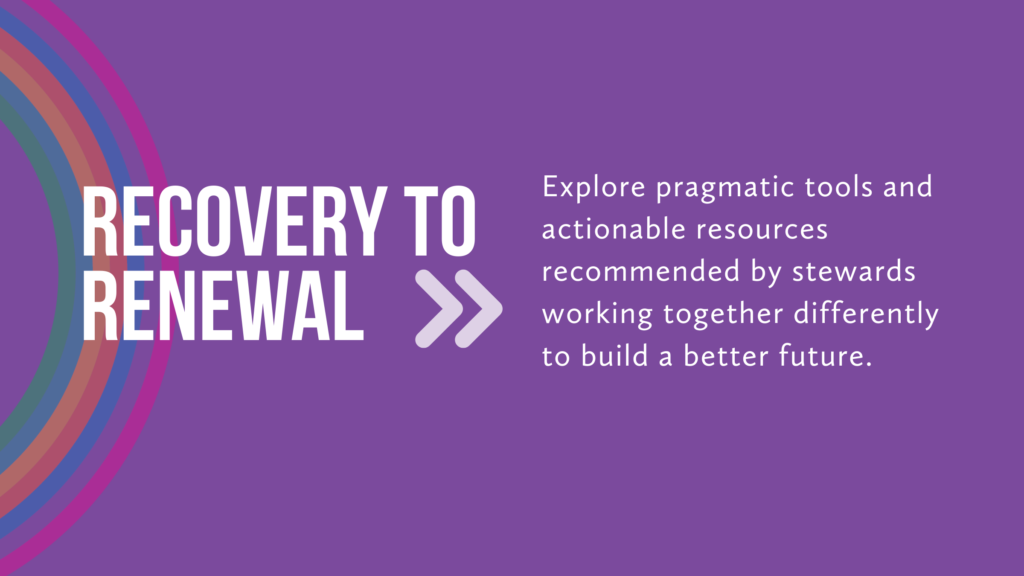
Recovery to Renewal
The federal government is making unprecedented investments in state, territorial, Tribal, and local governments. Never have communities had access to direct, flexible dollars at this scale. Explore pragmatic tools and actionable resources recommended by stewards working together differently to build a better future.
Click the table of contents button to explore our living library.
IN EARLY 2022, our country faces ongoing uncertainty and instability. We continue to grapple with the COVID-19 pandemic, the economic crisis, and the inequities of the systems that shape our lives. We know that rescue and recovery are no longer enough. Returning to the status quo is not an option.
Fortunately, there is reason for hope and even optimism. We have an immense reservoir of energy, courage, and imagination in communities across the country to create a better future together.
The federal government is making unprecedented investments in state, territorial, Tribal, and local governments. Never have communities had access to direct, flexible dollars. Never have communities had the opportunity to develop local solutions at this scale–solutions rooted in the voices and needs of residents.
Our best hope for equitable renewal is to organize local and national action around a single unifying and measurable expectation: All people and places thriving together, no exceptions. It conveys our commitment to create communities where all people have a fair chance to participate, prosper, and reach their full potential.
We see a way forward toward wider well-being, and we are eager to join with others in the work ahead. This page is a living resource co-created with national, state, regional, and local stewards leading the hard, healthy work necessary to create a better future.
Why Recovery to Renewal
This unprecedented investment of federal dollars requires us to work together differently. We know the status quo is not good enough and inequities are deepening.
Mindsets. Practices. Strategies.
We need mindsets, practices, and strategies that enable us to create legacies we are proud to pass along to future generations. We can chart a new course that renews our commitment to each other and fully realizes the founding commitments of our county:
- Dream big. The amount of funding available allows us to meet immediate needs–and expand the vital conditions for well-being and justice. We can respond to urgent requests and invest in critical infrastructure that takes time to develop.
- SLOW DOWN. Funding will be released over the next couple of years, with additional time for project implementation. We have time to deepen our engagement practices and create solutions together, with community.
- CENTER EQUITY. The federal government is advancing equity across its agencies, with funding sources, like the American Rescue Plan Act, explicitly prioritizing underserved and marginalized communities. Without centering the voices and experiences of those who are struggling and suffering the most, we will never create systems that allow everyone to thrive.
- BUILD BELONGING & CIVIC MUSCLE. Funding sources, like the American Rescue Plan Act, encourage community participation. This gives us a chance to build relationships, belonging, and a process rooted in co-creation. When we grow a sense of belonging, we strengthen civic life in our communities.
- act as stewards. Everyone who shares a commitment to well-being and justice, celebrates our interdependence, and bridges differences to work across boundaries can be a steward. We need the values, mindsets, and actions of stewards to operationalize this opportunity.
- Measure what matters. We will need to track our progress and report on how we use our funds. We have a chance to think strategically about the data we want to capture, including how we disaggregate data by race and ethnicity to understand the impacts of our decisions on communities of color.
Crisis creates an opportunity to change the system. But if we don’t apply an equity first approach, we are very likely to replicate or even deepen inequities.
Somava Saha, Executive Lead
Well Being & Equity (WE) in the World and the Well Being in the Nation (WIN) Network
What Resources Are Coming to Communities
STATE, TERRITORIAL, TRIBAL, AND LOCAL GOVERNMENTS have unprecedented access to investments from the federal government. The American Recovery Plan Act establishes the Coronavirus State Fiscal Recovery Fund and the Coronavirus Local Fiscal Recovery Fund to support local leaders.
Communities have access to ARPA funds through two pathways: direct relief and competitive grants. The Infrastructure Investment and Jobs Act offers another significant source of funding for communities.
The American Rescue Plan Act (ARPA) is once-in-a-generation legislation that will help strengthen communities that faced heavy economic losses during the pandemic. In addition to the $65 billion in direct relief allocated to all 19,000 cities, towns and villages, ARPA also provides more than $350 billion in competitive federal grants for local housing, health care, technology modernization, education, workforce, transportation, and economic development needs.
National League of Cities
This legacy moment has also impacted how government officials are developing and releasing “steady state dollars,” or ongoing programs and initiatives not considered to be solely focused on crisis response. The compounding crises of 2020 and 2021 have revealed not only the need to provide urgent services, but also the importance of investing in the vital conditions that we all need to reach our full potential. Our health and well-being is not limited to healthcare. Urgent services, like food pantries or unemployment insurance, and vital conditions, like humane housing and lifelong learning, are both essential and necessary for our health and well-being.
As we dream big, we have the opportunity to leverage direct dollars with competitive funding for response, recovery–and renewal. We can start to build a portfolio that includes urgent services and expands vital conditions.
One of the biggest lessons we’ve learned is the importance of bridging crisis response to our steady state programs. We need to continue to help the federal workforce–and the state and local and tribal and territorial counterparts–knit these streams back together, to see the strength that comes from combining crisis response and ongoing programming perspectives.
Rebecca Payne, Lead – Federal Plan for Long Term Recovery & Resilience (Temporary Assignment) at U.S. Department of Health and Human Services (HHS)
Communities in Action
Communities across the country are leveraging rescue and recovery funding to strengthen belonging and connection, implement multisolving innovations, and move toward their vision of renewal.
The National League of Cities and Bloomberg Philanthropies have teamed up to collect and share actions taken by local leaders in response to the COVID-19 Pandemic. The communities below are using the American Rescue Plan Act investments to grow practices and strategies for thriving together.
Explore More Communities in Action
- Helping residents ‘buy back the block’ with American Rescue Plan funds
- Community Transformation: North Sound Accountable Community of Health’s Journey
- WIN Community Pacesetter Stories: The Collection
- Actionable Ideas for Economic Recovery in American Cities
- Engaging People with Lived Experience Toolkit
Thriving Together in This Legacy Moment
This period will be remembered as the time when an invisible virus, an inequitable economy, an ailing democracy, and indelible images of police brutality exposed America’s staggering contradictions: our fates are intertwined, yet we continue to inflict inhumane, self-defeating harm on each other, and on the environment.
For those who care about well-being and justice, this is a legacy moment. We see a path forward, a path that requires repairing the legacies of trauma and exclusion. We must learn from the past, from the ways we have designed systems to create inequitable outcomes–and understand how the decisions of the past continue to shape our present and future.
We need to work together, across boundaries, to create legacies of dignity and inclusion. There is a role for all of us to act as stewards from our unique positions, sharing our strengths and assets. As the pandemic has unfolded, we have seen community members, nonprofit partners, government leaders, philanthropic leaders, and elected officials stand together and support their friends, families, neighbors, and communities.
The disruption of the last two years has revealed the failures of our systems in ways that can no longer be ignored–and has revealed that we have the collective capacity to do things differently, to create legacies for living together.
Lessons Learned
Moving from recovery to renewal means shifting our mindsets and creating legacies we are proud to pass along to future generations: legacies for living together. While this moment is unprecedented, we can learn from previous infusions of federal dollars.
PolicyLink, a national leader for racial equity, continues to harvest lessons learned from previous rescue and recovery efforts.
Explore More Lessons Learned
- Hurricane Katrina’s Lessons for Transformative Recovery
- Rebuilding Affordable Housing on the Gulf Coast: Lessons Learned in Mississippi from Hurricane Katrina
- 10 Priorities for Advancing Racial Equity Through the American Rescue Plan: A Guide for City and County Policymakers
- April 2020: Principles for a Common-Sense, Street-Smart Recovery
- Who Is Really Benefiting From the Tobacco Settlement Money?
I have an inherent belief that the more we take care of the people in our community, the better our economy and our society will be.
Liz Baxter
North Sound Accountable Community of Health
Moving into Shared Stewardship
To move from recovery to renewal–to create legacies for living together–requires a different type of leadership. We must act as stewards, shifting our mindsets and practices to meet this moment with the vision and skills required for transformational change.
While stewardship is not a new concept, we are embracing this expansive form of leadership–and are learning from communities that are building belonging and exercising civic muscle to create thriving people and places for all.
LISTEN IN as the Commons Good and UnSung Stewards podcasts connect with communities around the country to talk stewardship and starting points for learning and acting together to secure intergenerational well-being and equity for all. You will hear stories of thriving against all odds, embracing moments of joy, and showing resilience during the most difficult times.
Taking Action Together
Communities are working right now to respond to urgent needs and crises–and to explore how investments in vital conditions can strengthen systems and help us prepare for the next disaster.
While all communities have strengths, assets, and expertise in the people and places they call home, it can be hard to know where to start when it comes to dreaming big, slowing down, and centering equity.
Explore the tools and resources below to help jump-start your path toward renewal.
Explore More Pivotal Strategies to Advance the Seven Vital Conditions
- Thriving Natural World
- Basic Needs: Freedom from Trauma, Violence, & Addiction
- Basic Needs: Public Health
- Basic Needs: Health Care
- Basic Needs: Food
- Humane Housing
- Meaningful Work & Wealth
- Lifelong Learning: Cradle to Career
- Lifelong Learning: Higher Education
- Reliable Transportation
- Belonging & Civic Muscle
Stay Connected
We are continuing to learn and evolve this page–and want our resources to be useful and pragmatic. Tell us what you are learning and what you need. What would help you on your path to renewal?
Go to the full page to view and submit the form.
